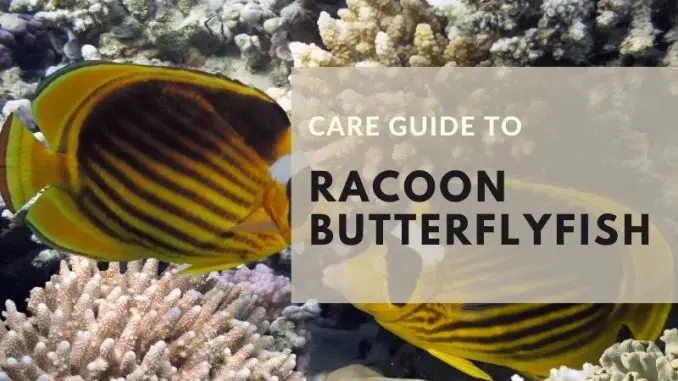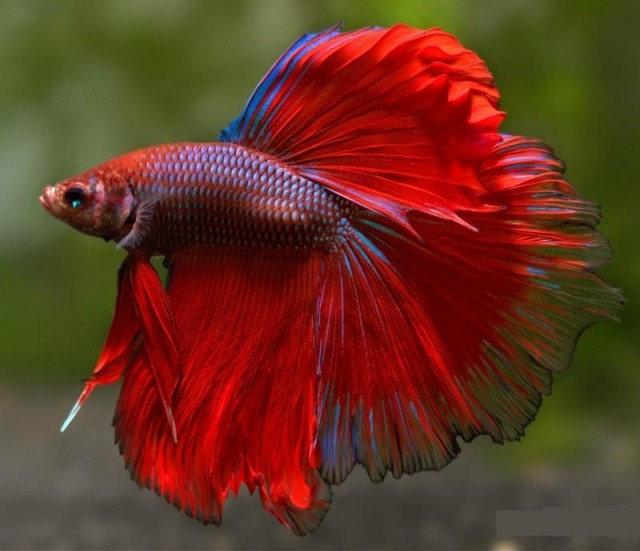Raccoon Butterflyfish Care Information & Species Profile

The raccoon butterflyfish is a saltwater species of the butterflyfish household. There are round 129 species of butterflyfish, and the raccoon species has yellow, white, and black colours much like different fish in its household.
The raccoon butterflyfish’s most original characteristic is the daring black and white markings round its face, resembling the markings of a raccoon.
These fish are well-liked with aquarists as a result of their distinctive look and their low care wants, regardless of needing to be housed in a much bigger tank than most different saltwater fish.
Raccoon Butterflyfish Information & Overview
| Scientific identify: | Chaetodon lunula |
| Widespread names: | Raccoon butterflyfish, raccoon coralfish, crescent-masked butterflyfish, halfmoon butterflyfish, moon butterflyfish, lunule butterflyfish, and red-striped butterflyfish |
| Distribution: | Indo-Pacific areas, together with Hawaii, Japan, East Africa, and Fiji. Jap Pacific areas, together with the Galapagos Islands and Costa Rica |
| Measurement: | 6–8 inches |
| Life expectancy: | 5–7 years |
| Coloration: | Yellow-orange, with black and white patches |
| Eating regimen: | Omnivore |
| Temperament: | Peaceable |
| Minimal tank measurement: | 75 gallons |
| Temperature: | 74–80°F (22–27°C) |
| pH: | 8.2–8.4 |
| Hardness: | 5–15 dGH |
| Care degree: | Straightforward |
| Breeding: | Egg scatterer |
Origin & Distribution
The raccoon butterflyfish is often present in areas throughout the Indo-Pacific, together with Hawaii, Japan, East Africa, and Fiji. The fish can also be present in Jap Pacific areas, together with the Galapagos Islands, Ecuador, and Cocos Islands in Costa Rica.
The pure habitat of the raccoon butterflyfish is numerous sorts of reefs, together with seaweed reefs, flat reefs, slope reefs, and fringe reefs. Racoon butterflyfish favor to stay in water depths of 98 ft or much less, in small teams of as much as 20 fish.
Grownup Measurement & Lifespan
Totally-grown raccoon butterflyfish attain 6–8 inches lengthy. Some males are bigger than females.
The typical lifespan of this species is 5–7 years. In an appropriate captive surroundings, raccoon butterflyfish stay as much as 10 years.
Availability
Raccoon butterflyfish are costly fish. The typical price of a raccoon butterflyfish is $60–$90.
Raccoon butterflyfish aren’t as ample as different saltwater fish as a result of breeding butterflyfish in captivity is troublesome. The fish are extra extensively obtainable on-line than in native shops.
Respected on-line shops promoting on-line raccoon butterflyfish are:
Look & Conduct
The raccoon butterflyfish is a medium-sized, oval-shaped fish with a peaceable persona and good compatibility with different fish.
Colours, Patterns, Fins, and Intercourse Variations
Raccoon butterflyfish have unusually massive eyes and distinct masked faces that resemble the markings of a raccoon. This species is a vibrant, daring, and colourful fish, with a yellow-orange physique with white, black, and yellow markings across the eyes, and a black spot close to the tail.
The physique of the raccoon butterflyfish is compressed and oval-shaped, with a truncated tail fin and a steady dorsal fin from head to tail. These fish have brief, protruding snouts and small mouths.
Juvenile raccoon butterflyfish aren’t as boldly coloured as adults, and juveniles don’t have the center black band. There’s no distinguishable distinction in look between female and male raccoon butterflyfish.
Raccoon butterflyfish make their colours brighter or dimmer to mix in with their environment. The fish’s colours fade in the course of the nighttime to mix in with the coral reefs, and the colours turn out to be brighter when the fish feels antagonized.
Typical Conduct
Raccoon butterflyfish are peaceable and behave sociably with different fish species. Nevertheless, the species is thought for its territorial behaviors, together with chasing and nipping, round fish of its personal form in captive environments.
In the course of the day, raccoon butterflyfish keep largely hidden, and at evening, the fish emerge from their caves and corals to hunt for meals. In captivity, the fish might be skilled to eat in the course of the day, and are pleased to discover tanks with low lighting at any time of the day.
Raccoon Butterflyfish Care & Tank Necessities
Caring for raccoon butterflyfish is straightforward, so long as you present the suitable tank setup for this saltwater fish species. Raccoon butterflyfish want a coral-based tank, glorious filtration, and extremely oxygenated water. The fish comply with a carnivorous weight loss program.
Habitat and Tank Necessities
The raccoon butterflyfish’s pure habitat is coral reefs, however the fish is thought to destroy coral. Home the raccoon butterflyfish in a tank with a fish-only-with-live-rock (FOWLR) aquascape, consisting of lifeless coral.
Guarantee your raccoon butterflyfish tank is at the very least 75 gallons for a single fish. Raccoon butterflyfish turn out to be burdened once they’re housed in crowded tanks, they usually want loads of area to swim.
The most effective substrate for a raccoon butterflyfish tank is ok sugar sand as a result of it’s simple to scrub and retains the ammonia and nitrate ranges down. Add between 1 and 5 inches of substrate to the underside of the tank.
Raccoon butterflyfish want a lot of hiding locations and locations to assert as their territories, resembling rocks and caves. Anubias and bolbitis are hardy, sturdy crops for a raccoon butterflyfish tank, and floating aquarium crops like Java moss are different good crops to think about.
Tank Situations
The perfect tank circumstances for raccoon butterflyfish are:
| Water kind: | Barely alkaline, extremely oxygenated saltwater |
| Tank measurement: | Minimal 75 gallons, or 150 gallons for 2 butterflyfish |
| Water temperature: | 74–80°F |
| Substrate: | Advantageous sugar sand |
| Tank setup: | Rocks, caves, crops |
| Acidity: | 8.2–8.4 pH |
| Water hardness: | 5–15 dGH |
| Filter: | Sure, clear water circumstances are important for a butterflyfish tank, and a powerful filter is required |
| Bubbler: | Sure, to oxygenate the tank |
| Lighting: | Sure, raccoon butterflyfish favor medium tank lighting |
| Water heater: | Sure, to maintain the water heat |
Raccoon butterflyfish are delicate to modifications in water chemistry, so distinctive water high quality is crucial to stop stress and illness.
Crucial facet of caring for this fish is retaining the tank clear by performing a ten–15% partial water change each two weeks.
Illness
Raccoon butterflyfish are susceptible to a number of frequent saltwater aquarium illnesses:
Marine I
Marine or saltwater ich, or white spot illness, is attributable to a protozoan referred to as Cryptocaryon irritansand is characterised by white spots on the fish’s scales. Fish with marine ich expertise pores and skin irritation, seem torpid, and lose their appetites. Extreme instances of marine ich trigger respiratory misery and demise.
Deal with marine ICH by transferring the affected fish to a quarantine tank and including copper-based drugs to the tank.
Velvet
Marine velvet is a illness attributable to a single-celled dinoflagellate, leading to dust-like white sprinkles all around the fish’s physique. Velvet seems to be much like ich, however velvet spots are smaller and rounder than ich spots. Fish with velvet lose their appetites, act reclusive, and exhibit heavy respiration. It’s frequent for fish with velvet to swim towards the movement of the tank’s water pump.
Deal with velvet with a chloroquine phosphate or copper medicine, as beneficial by your veterinarian.
Uronema Marinus
Uronema marinum is a ciliate parasite that lives, feeds, and reproduces on saltwater fish. Fish with Uronema marinum have bloody, ulcer-like wounds on their our bodies and excessive mucus formation on their scales. Weakened fish usually tend to be affected by Uronema marinum than wholesome fish, so guaranteeing clear, spacious tank circumstances drastically reduces the probability of this parasite infecting fish.
Deal with Uronema marinum with antibacterial medicine beneficial by your veterinarian.
Raccoon butterflyfish are illiberal to sure drugs, so sustaining distinctive water circumstances is crucial to stop illness within the fish.
Tank Mates
Raccoon butterflyfish are appropriate with most saltwater fish species, however they shouldn’t be housed with different raccoon butterflyfish except the tank is sufficiently big to offer the fish their very own territories.
Nice tank mates for raccoon butterflyfish are:
Keep away from housing raccoon butterflyfish with small, territorial fish, like triggerfish, scorpionfish, and clownfish, and invertebrates like shrimp and snails, which raccoon butterflyfish are identified to eat.
Eating regimen and Feeding
Within the wild, raccoon butterflyfish eat algae, coral polyps, and invertebrates like tubeworms and nudibranchs. Present the same mixture of meals for the fish in captivity.
Getting a raccoon butterflyfish to eat might be difficult at first. Strive engaging the fish’s urge for food with a small anemone, or stay or frozen fish cubes.
As soon as the raccoon butterflyfish has adjusted to its new surroundings, present a day by day weight loss program of stay or frozen invertebrates, like brine shrimp, crab, cockles, and squid. Dried seaweed and algae wafers are good plant-based meals for raccoon butterflyfish.
Complement the fish’s weight loss program with high-quality, vitamin- and mineral-enriched fish flakes designed for angel and butterflyfish.
Feed raccoon butterflyfish a pinch of meals 3 times a day, rotating the kind of meals to fluctuate the fish’s weight loss program. After the fish have completed consuming, take away any leftover meals to stop the tank from getting soiled.
Breeding
Breeding raccoon butterflyfish at house is troublesome — even some skilled breeders are unable to efficiently breed the fish in captivity. Raccoon butterflyfish attain sexual maturity once they’re about one 12 months outdated.
Within the wild, right here’s what occurs when raccoon butterflyfish breed:
- An female and male raccoon butterflyfish pair up and transfer into the shelter of a cave or coral reef to start the breeding course of.
- When the feminine detects that the tide and the lunar cycle are proper for egg-laying, she scatters her eggs within the water.
- The male fertilizes the eggs, then the eggs are taken away by the present, the place they turn out to be a part of the planktonic water column.
- The eggs hatch after about seven days. In a post-larval state, the fry are constructed to outlive with out parental care and have bony plates on their our bodies to guard them from the weather.
Making an attempt to breed raccoon butterflyfish is ok, however bear in mind that you just’re unlikely to see outcomes, and the fish could bully each other to demise.
Ought to You Get a Raccoon Butterflyfish for Your Aquarium?
Raccoon butterflyfish are stunning, attention-grabbing fish. You need to get a raccoon butterflyfish when you have a big, established tank, with loads of open water and hiding area, and also you’re ready to maintain the tank clear with common water modifications and high-quality filtration.
Don’t get a raccoon butterflyfish in case you battle to keep up your tank’s water parameters, or your tank incorporates territorial fish which might be identified to trigger battle with butterflyfish.
Regardless of their want for a big, constantly clear tank, raccoon butterflyfish deliver a vibrant pop of shade and loads of leisure to a group saltwater tank.









